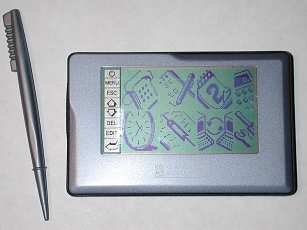
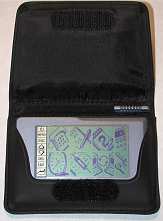
| Official
Gadgeteer Hands On Review: Oregon Scientific ECHO
PDA (PDA-293) by Julie Strietelmeier Last date revised: 04/20/2001 |
Product Requirements:
Desktop:
Windows 95, 98
The ECHO PDA from Oregon Scientific is a REX-like device. As a PC card sized PDA, the REX became popular in 1997. An updated version named the REX Pro was released a year or so later. There have been subsequent other upgrades with the REX 6000 by Xircom being the latest. These very small PDAs can actually be inserted into the PC Card slot of a notebook computer to sync or transfer data.


The ECHO PDA while similar in looks to the REX series, can not be inserted into a PC Card slot. It does however have a touch screen like the latest REX 6000.
Hardware Specs:
Memory: 512k
LCD: Gray Scale
Powered by: two CR2025 3V lithium cell batteries (included)
Serial cradle
Size: 3.34 x 2.13 x 0.25 in
Size-wise the ECHO is great. You can stick this thing in your pocket (don't sit on it though), or your purse and you'll pretty much forget that it is there. The front and back of the device are made of metal with the middle being plastic. It feels very sturdy. I tried the to twist the unit to see how flexible that it was, and it didn't budge.
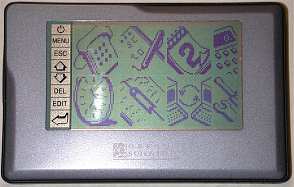
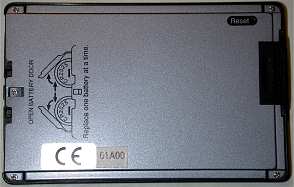
The screen takes up most of the front real estate. The ECHO uses a mono LCD that isn't the easiest on the eyes. There's no comparison between this display and that of REX PDAs or even the older Palm Pilots for that matter. The ECHO screen has a major glare problem. I found it very hard to read in different lighting conditions... especially low light. Unfortunately it does not have a backlight either.
The screen is a touch screen also. The ECHO does not have any type of handwriting recognition, but you can tap the screen with the included stylus to navigate and use the onscreen menus / keyboard. The sensitivity of the screen isn't very good. I found myself tapping more than 1 time to get the desired menu item or letter to appear. This can become very annoying...
The left side of the ECHO has a small rubber cover that hides the sync port. You remove this cover and then insert the ECHO into the included serial docking cradle. When the ECHO is inserted correctly, a small LED glows green on the cradle. I had quite a bit of trouble with the cradle and syncing the ECHO with a PC. I don't think the connection between my PDA and the cradle was very reliable. The LED indicator when go on and off or would glow dim. However, adjusting the position of the PDA in the cradle would most often fix the problem.... until it occurred again.
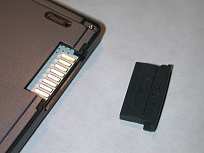
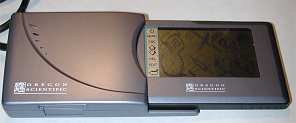
The right side has two coin cell battery compartments. The lithium batteries are included with the ECHO. I'm not sure how long they are rated to last in the PDA before replacement. I have had the ECHO for several months and am still on the first set of batteries.
The back of the unit has a reset switch which requires a paperclip or other pointy object to activate.
The main interface of the ECHO is thru the screen. There are no buttons on the device. There is however a button bar on the left side of the screen. These buttons can be pressed with the stylus and allow you to turn the unit on/off, bring up the main menu, escape menus, scroll, delete, edit and press return in input boxes.
All data input is done thru an onscreen keyboard. Entering data this way is VERY tedious. You are much better off entering data thru the desktop application.
The desktop application reminds me of an old Windows 3.1 application. Although the documentation on the packaging says that the ECHO syncing software syncs with Outlook, Act!, Goldmine, Lotus Organizer and Schedule+, you actually have to import comma separated files from those programs into the ECHO desktop program. It's clumsy and requires you to map fields that you want to sync. I wasn't successful in syncing my Outlook data to the ECHO and finally gave up after the several tries. The included manual does not give you any instruction for importing data.
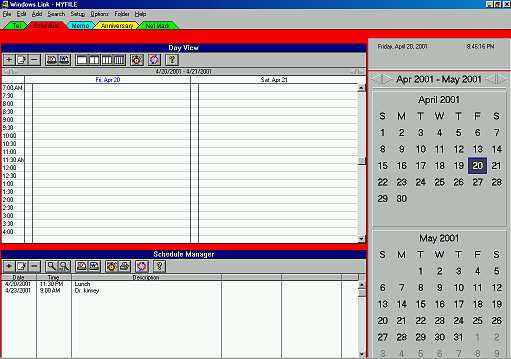
Now let's take a look at each of the built-in applications.
Phonebook
This is the application where you keep names, addresses and phone numbers. You
are allowed 3 categories with which to sort the contacts: Business, Friends, and
Others. There is also the All category where all the names will be listed.
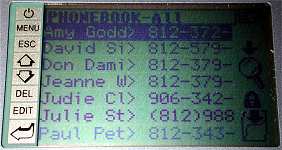
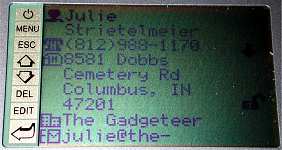
When you create a new contact, you can enter the following information for each person: Name, Telephone Number, Home Address, Company Name, Company Telephone Number, Company Address, Company Fax Number, Email Address, Mobile Phone Number, Job Title, Birthday and Remark.
Because the screen on the ECHO is so small, the list view of the Phonebook can only show part of the name and part of the phone number. You can't change anything with the view. I think there should be an option to just show the name. The list view is sorted by name, But the problem is that it is sorted by the first name instead of last name. So, if you want the names sorted by last name, you need to input the names last name first. I think this is a major gotcha with this app.
Notepad
This is just a small memo type application. The thing that makes it pretty much
useless is the fact that each memo can only be 100 characters total. And just so
you know, 100 characters is about the length of the previous sentence. One
annoying fact is that you can add larger memos to the desktop application, but
it will tell you that they won't sync to the ECHO if they are longer than 100
chars. The thing is that they DO sync the first 100 chars and then you get an
error.
Calendar
The Calendar application allows you to look keep track of your appointments.
There are two views, the full month view and the daily schedule view. The full
month view shows the current month with those days that you have appointments,
underlined. You can then tap on a date and see that day's schedule.

You can also set alarms to go off to remind you of an appointment. The alarm sound is very soft and hard to hear unless the ECHO is taped to the side of your head. So if you have it in your pocket, don't count on noticing the beeping. You also can not set the alarm time to go off a few minutes before the actual appointment, it will go off at the start time of the appointment.
Calculator
3 different calculators; basic, metric conversion, and currency conversion are
included on the ECHO.
World Time
This is a simple time application that shows an analog clock with a moving hour,
minute and second hand. You can choose your home city from a list of 100 cities.
Unfortunately, you can't add your own city to the list, you have to pick the one
nearest you. A small button lets you toggle Daylight Savings time on and off.
This application also allows you to set a daily alarm.
Bookmarks
This application lets you collect website addresses. Why you'd want to do this
is really beyond me... It's not like you can do anything the info except look at
it. The info is also stored in the desktop application which also doesn't let
you do anything with it. I could see it being minimally useful if you could at
least click on the URLs in the desktop app and have it launch a browser with
that website.
PC Sync
You have to initiate this application in order to sync with the desktop.
System Setup
With this app, you can turn the key tone on/off, change the time format, date
format, screen contrast, password and delete records.
Bottom line, the ECHO is too expensive for what it can do. Sure, it's small
and easy to carry... But it is slow, hard to see, has a lousy user interface and
is not that powerful. For about $30 more, a person would be much better off
buying a Palm m100 instead. Or, if money is a
real issue, I think a much cheaper pocket databank type PDA would be a better
choice than the ECHO.
Price: $99.99
Pros:
Small
Portable
Cons:
Less than friendly user interface
Slow
Expensive
No backlight
| Let me know your comments
on the ECHO PDA and read what others have to say. |